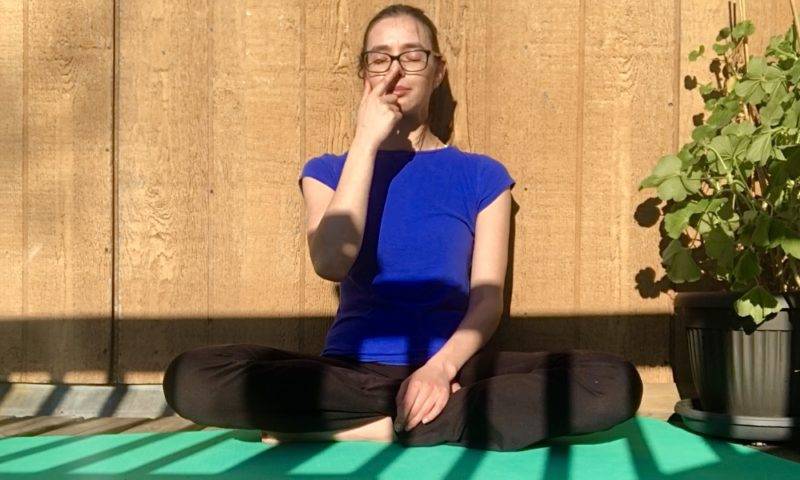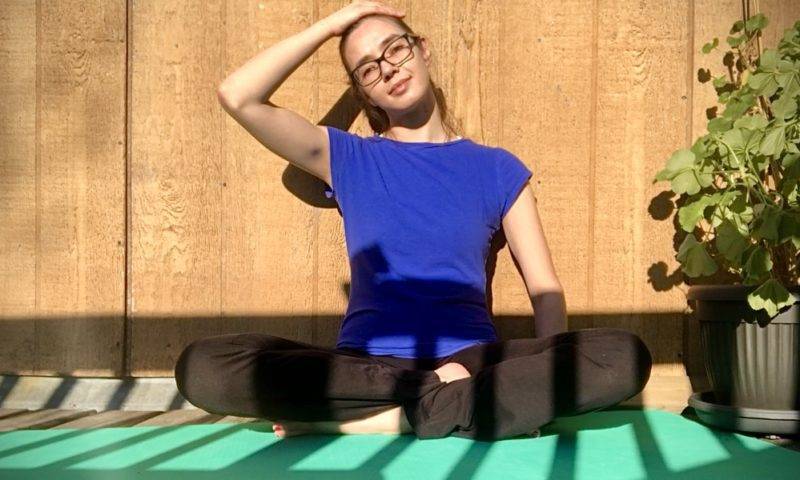By Nicole Dagher, RMT
Practicing social distancing over the last few weeks has us relying a lot more on our phones, laptops, and other devices to keep connected. As a collective, never before have we faced such pressure to slow down and observe our natural patterns and behaviors, re-evaluate what’s important, and adapt our lifestyles to thrive in this incredibly fast-paced world.
Connecting virtually through social media and online platforms has become our most accessible and far-reaching way of sharing information and keeping conversations flowing. Right on the heels of heightened connection though, is the nemesis of being glued to our screens, now more than ever! -Cue the orchestra of creaks and cracks in your neck- (and trust that you are not alone with your aches and pains or tension headaches). It’s important to ensure that we are taking regular breaks from our screens (ideally getting up once every hour for at least 15 minutes). That said, if you have a few minutes to spare, (and if your neck can bear it) hang in while I share some easy and effective tips for fitting in the ultimate self-care routine for the head, neck & shoulders.

Why is focusing on the Neck so important?
The neck muscles work collectively to stabilize the upper spine and support the weight of our head. They help us to perform compound movements like flexion, extension, side flexion, and rotation. When we are sitting for prolonged periods, and especially when our eyes are constantly scanning to read our screens, it is common for the neck muscles to get tired. As they fatigue, they enter into “protective mode” and we might experience a “kink” or muscle spasm, sometimes along with a nagging headache. Ensuring that our neck and shoulder muscles are regularly stretched or strengthened is important in helping to maintain overall tissue health, range of motion, and integrity in the small joints and disk spaces of the cervical spine. Usually, your Chiropractor, Physiotherapist, or Massage Therapist might recommend specific exercises for you. Under these circumstances, however, I have chosen 4 exercises to share with you that anyone can benefit from. Especially when done together and consistently, these exercises are very effective for the maintenance and prevention of general musculoskeletal pain or discomfort in the head and neck.
Welcome to your next challenge: Carve out 5 minutes a day; if you can, before even getting out of bed in the morning, and give your hard-working neck and shoulders a bit of movement and stretching before your day starts. And guess what?!-If you are someone who NEEDS to jump out of bed and get your morning coffee brewing before all other priorities, then all hail to the coffee!!! The best practice is this: try to work in the 5-minute pause at a time that feels right for you (think right after a shower, while the coffee is brewing, before or after waking up the kids, before or after checking your emails, etc.).
Especially with reduced access to in-person treatments, the key to longer-lasting tension relief is consistency in home-care practices, so you might as well tailor your routine to meet where you’re at.
Try out these stretches for general neck mobility:
*Note: It is perfectly normal to experience slight discomfort doing any of the following stretches.
Ensure breathing is fluid and not forced in any way and be careful not to hold your breath when you hold a stretch or meet a new resistance in the tissues. Stop right away if you feel any pain.

Exercise 1-Neck Mobility: Circles with the Nose
Begin by nodding/shaking your head yes/no. Moving at a comfortable pace of your own, draw 5 small circles with the nose moving in a clockwise direction. Notice and become aware of the movement in your neck. Reverse your direction for 5 more small circles. Create 5 slightly bigger medium-sized circles with the nose; reverse direction for 5 more circles like this. Lastly, moving clockwise, draw 5 large circles with the nose, rotating the head and neck gently as you do. Reverse your direction for 5 more large rotations. Carefully rotate gently back over any angles in your range that feel “crunchy” or “stuck.”
Benefits:
-
- Kick-starts circulation and lymph flow in the upper back and neck
- Improves joint health and mobility of the neck in all essential ranges of movement (when done consistently)
- Prevents stiffness and muscular pain from guarding due to weakening or instability in the joints of the neck

Exercise 2-Stretch: Splenius Capitis Muscle
Sit up straight with your feet outstretched in front of you or alternatively, relax in a comfortable seat with your feet and hips square to the floor. Pull your neck back slightly and tilt your chin in towards your throat. (This motion feels like creating a “double-chin.” Place your hands on the back of your head and gently guide your head towards your chest. You should feel a nice stretch at the back of your neck and head that sometimes even extends along the spine or between the upper shoulders. Try holding the stretch for 30 seconds or longer if desired.
Benefits:
-
- Reduces built-up muscular tension in the back of the neck and at the base of the skull
- Can prevent and alleviate tension headaches
- Helps to give the muscles of the eye a rest from scanning/reading

Exercise 3-Stretch: Scalene muscles
Sit up straight but relaxed in a comfortable seat. Sit on your left hand to anchor the shoulder down. Tilt your head to the right to stretch your left side. If you feel an adequate amount of stretch, stay here. Try holding for 30 seconds. If you want more, bring your right hand to rest on the top of your head and add a gentle pull. Repeat on the right side, sitting on the right hand to anchor the shoulder down, as you place the left hand on your head to add a gentle stretch for the right side. Try holding for 30 seconds each time or longer if needed.
Benefits:
-
- Reduces tension and muscle guarding in the sides of the neck which are accessory muscles of breathing and tend to overwork in stressful situations
- Helps to create space and mobility in the neck where the brachial plexus (a bundle of nerves) is located, which can relieve symptoms of general tension and numbness or tingling
- Alleviates chronic stiffness and muscle guarding in the neck due to previous neck/head injuries or from “carrying stress in the shoulders”
If you’re just starting your routine, try these 3 exercises once a day for 3 weeks and see how you feel. If you’re enjoying these exercises and feeling a benefit from doing them in the A.M., you might have the idea to carve out another 5 minutes before bedtime to repeat the same routine for an extra-sound sleep. (3 exercises, 2x/day, for 3 weeks).
And if you are feeling really ambitious, you might hold certain stretches for longer, repeat a few, or for even better results, add in an afternoon session of the same routine (3 exercises, 3x/day, a total of about 15 minutes in your day, for 3 weeks). This mid-day option is a great way to take the edge off of any midday stiffness that creeps its way in while we are cooped up at home and on our screens. The more frequently you set aside these few minutes of your day, your stretching routine can become second nature and something you may even look forward to.
Remember that creating a routine for yourself when all structure and organization as we know it has fallen, is no easy task. Let’s be real: sometimes self-care means falling out of routine too; but it is a much smoother process of coming back when we have the practices in place for giving ourselves what we need. Let your routine be flexible enough to be realistic for you and do your best not to deny your mind or body what it is asking for.
Nicole would love to know: What would be the most valuable tool or information to receive from your massage therapist at this time? Email us with your feedback!
Stay safe & be well,
-Nicole

